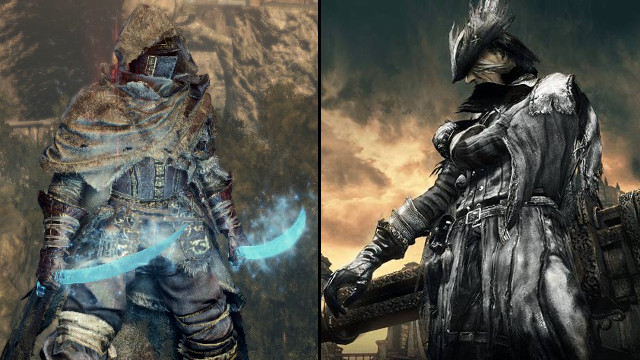Dark Souls 3 has quickly become a treasured artifact among the gaming community. It's the final Souls game to be released by FromSoftware, and in several ways it's the best that the studio has ever produced.
Dark Souls 3's success is particularly powerful given the prestige of its predecessors, and therefore the enormously high expectations that were set before it. Dark Souls is regarded as one of the best RPGs in history, while Bloodborne remains the best RPG of the current generation.
Given that Dark Souls 3 and Bloodborne have released within the same era, they make for a fair and interesting comparison. Let's dive in and see how these two action RPG giants hold up to one another.
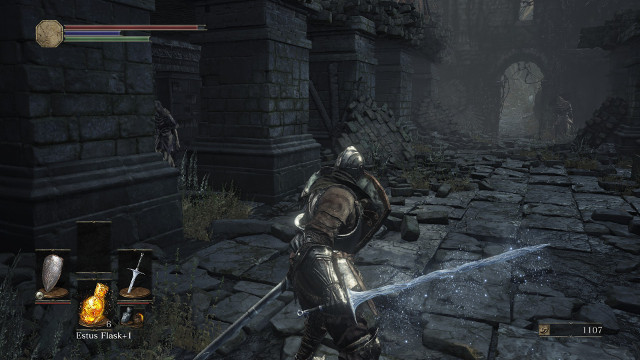
Controls
Prior to the release of Bloodborne, Souls combat was held back by some minor control issues; movement, rolling, and attacks sometimes betrayed the trust of the player, providing frustration in the franchise's unforgiving environments. Bloodborne delivers the first thoroughly satisfying combat experience by FromSoftware. Every attack and roll is executed with precision thanks to improvements made to the proprietary game engine, providing a reliable environment that gains equity with the players who inhabit it. This has earned deserved praise among gamers, especially RPG fans who have been let down by many other action RPGs during years prior.
Dark Souls 3 runs on the same engine with adjustments that improve the quality of life in subtle ways. The major difference comes down to control design, where Bloodborne favors faster-paced combat with more healing items available as well as a Regain system that offers an opportunity for players to earn back lost health through quick counter-attacks. In contrast, Dark Souls 3 slows things down a notch and lets players approach encounters in the way they prefer.
Where the biggest deviation comes into play is with the camera and lock-on systems. Bloodborne made some improvements to what was in prior Dark Souls games, but its more claustrophobic level design and less effective pivoting and collision handling sometimes leads to troublesome death. FromSoftware addressed these concerns and implemented improvements with Dark Souls 3. In most games these improvements would be looked at as inconsequential, but Souls is no ordinary franchise. It's punishing, and makes every little mistake potentially heart-breaking. As such, Dark Souls 3's more intuitive camera and lock-on make for a much more consistently satisfying experience.
The combination of minor improvements to combat feel as well as an update of lock-on and camera mechanics has resulted in Dark Souls 3 taking this category.
Winner: Dark Souls 3
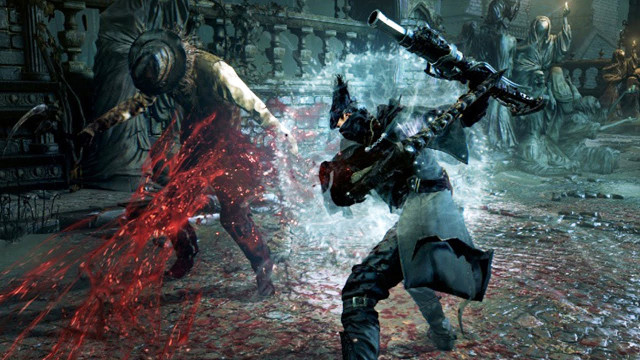
Gameplay
Bloodborne's effort to reward aggressive play using quicker movement and the Regain system makes this comparison partially dependent upon the tastes of the player. Gamers who prefer more action-oriented battle systems, such as those in Bayonetta and Devil May Cry, have in many cases found Bloodborne to be the pinnacle of FromSoftware gameplay design.
Nonetheless, Bloodborne goes beyond just making things "faster" by introduced the Transforming Weapons system, which allows for every weapon in the game to function as if it were two separate weapons capable of comboing between the two mid-attack. It is an exciting system that helps encourage aggressive play, something that most Souls players shy away from due to the danger involved.
ALSO READ: 10 Dark Souls 3 Secrets You Probably Missed
What Dark Souls 3 does in response to the success to the Transforming Weapons system is called Weapon Skills. Essentially, every weapon in the game has a special mode of attack, and there are many flavors ranging from applying unique but temporary augmentations to a weapon, to a rushing charge, or even flashy sequenced attacks. In most cases, these skills function as interesting but uncommonly utilized abilities. Transforming Weapons was something thoughtful and used by everyone, making it a better system.
These two games have weapons that feel identical in many instances, so the Transforming Weapons versus Weapon Skills becomes the major player in regards to gameplay. And ultimately, Bloodborne's system is more well thought out.
Winner: Bloodborne

Level Design
Dark Souls 3 has phenomenal level design. Not only does it supply a wealth of unique and captivating levels to explore, but they are consistent in quality. By the end of the journey you feel like you have been to many epic places, from the death inhabited grounds of Undead Settlement, to the mystical skyline of Irithyll of the Boreal Valley. Prior games had notable low points, such as Dark Souls' Blighttown and Catacombs, and Dark Souls 2's Shrine of Amana and Black Gulch. Bloodborne similarly suffered from inconsistency with Unseen Village and Nightmare of Mensis. Dark Souls 3 comes out on top.
Bloodborne bites back with its mixture of open-world and linear level design, which find a healthy balance between providing focused direction and satisfying exploration. Dark Souls 3 provides very little room for level deviation, and outside of a couple forks and small handful of optional bosses, is the most linear Souls game since Demon's Souls. Bloodborne's more undirected level flow is sorely missed.
Bloodborne and Dark Souls 3 succeed in different areas of level design, resulting in a tie for this category.
Winner: Tie
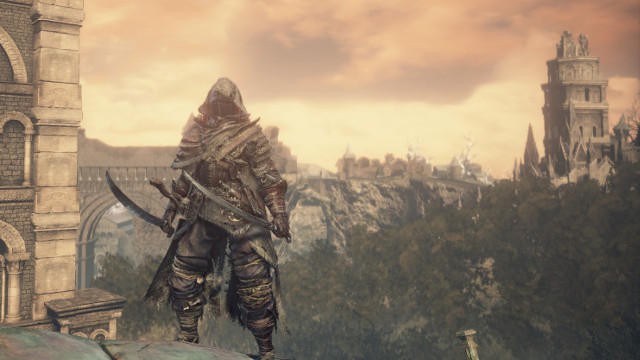
Diversity
Having a wide breadth of options for how to enjoy a game is a very important factor for RPG fans. Unfortunately, while Bloodborne succeeds in many ways, it suffers in regards to diversity. It has only 15 right-hand weapons, which rely heavily on Transform Weapons to provide variation. This small number of weapons is made far worse by the game's ineffective ranged weapons, which make up nearly half of its weapon count. This, combined with the removal of shields, results in few options and thus decreased encouragement for multiple playthroughs.
In contrast, Dark Souls 3 is bustling with weapons. There are over 80 of them, resulting in far more treasure to be found, and more reason to play through the game multiple times Heck, there are more weapon categories in Dark Souls 3 than there are weapons in Bloodborne.
ALSO READ: 10 Fun Build Ideas For Bloodborne
Dark Souls 3 one-ups Bloodborne yet again in terms of build design. Dark Souls 3 not only has more attributes for players to spend points on, but more of them are effective and balanced. There are three schools of magic, dexterity-based weapons, strength-based weapons, quality weapons, and a huge number of ways to upgrade and augment weapons to fit the tastes of a player.
Dark Souls 3's diversity leaves Bloodborne in the dust.
Winner: Dark Souls 3
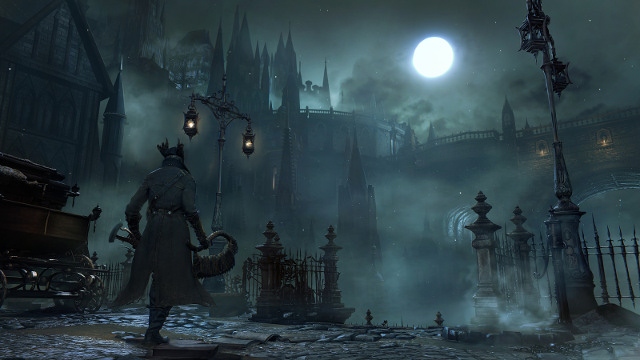
Theme
Bloodborne's world is second to none. Its gothic architecture, undead foes, and mist-packed pathways are a sight to behold. The game manages to edge toward being a horror game with its dark imagery that makes sure players are careful where they step.
Dark Souls 3 continues in the tradition of the franchise with medieval areas that are well-crafted, but not too dissimilar to many competing games on the market. Though, it does take hints from Bloodborne with a couple of its areas, which have similarly ominous qualities.
Bloodborne's deviation from the tried-and-true medieval themes of Dark Souls makes its theme more interesting, and certainly more unique.
Winner: Bloodborne
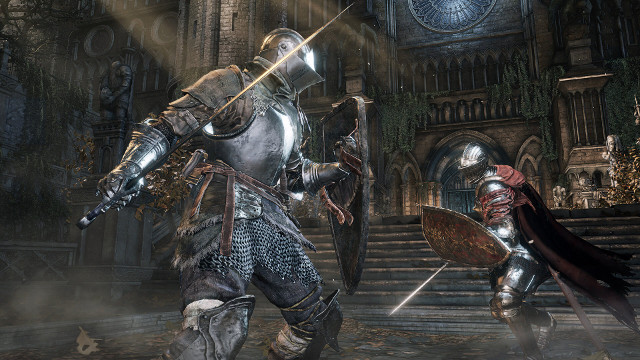
Presentation
Many Souls fans were hoping by now that frame pacing would be eliminated from the franchise. However, that isn't so. Although both Dark Souls 3 and Bloodborne suffer from this technical oddity, they are still wonderfully crafted games. Everything from their user interface to environmental art leaves a lasting impression on the senses, and are leaps and bounds improved from prior games.
If you happen to have a powerful gaming computer, then Dark Souls 3's PC version is something you need to try at one point or another. Its 60 frames per second and improved image quality results in the best-looking FromSoftware game in history, meaning that Dark Souls 3 has achieved higher potential than Bloodborne.
That said, Bloodborne is more consistent with its presentation. Dark Souls 3's early levels are overly familiar and appear less polished than later areas, unlike Bloodborne.
Both of these games have superb presentation, only held back by some minor shortcomings.
Winner: Tie
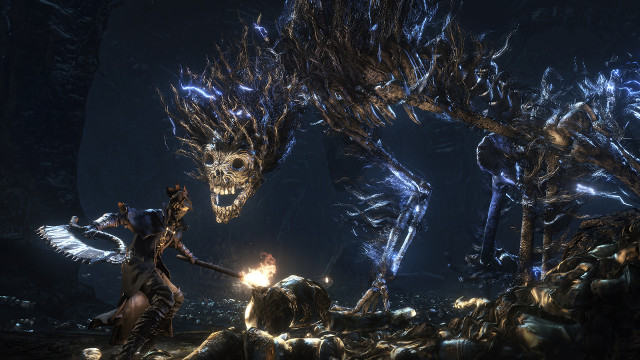
Difficulty
Bloodborne's sense of challenge is a far cry from the mercilessness of the original Dark Souls, which left many newcomers packing their bags and leaving. It was no coincidence, either. With Bloodborne's exclusivity, FromSoftware and Sony wanted to capture a large audience while retaining the heart of what made its past games great. The result was its most manageable game yet, but one that did have some noticeable inconsistencies.
Balance is something that many Souls fans don't often talk about, but is extremely important. These games thrive on their sense of challenge, but having huge spikes in difficulty isn't the result of FromSoftware trying to offer fans a digital trophy to brag to their friends about. Instead, it's the result of inadequate testing and polish. Dark Souls 3 is the first game in its series to find a near perfect sense of balance. There's a soft curve of difficulty that it follows, easing newcomers into the franchise, while offering a final few hours that test the skill and mettle of even the most battle-hardened.
ALSO READ: 10 Things I Wish I Knew Before I Started Dark Souls 3
In addition, Bloodborne departs from the Estus Flask system with what it calls Blood Vials. While Blood Vials similarly have a limit of how many you can carry, which can be upgraded later in the game, they don't replenish upon visiting a lantern (bonfire). Instead, you need to collect them from enemies not to dissimilar to Demon's Souls' Moon Grass. The artificial difficulty resulting from this system results in some seriously unnecessary farming that gets in the way of the game's enjoyment.
Dark Souls 3 is a difficult, but fair game with great game flow. It is one that is pleasant to play, and doesn't interrupt the game flow with ridiculous obstacles. For this reason, it wins this category.
Winner: Dark Souls 3

Multiplayer
The multiplayer experience for both Dark Souls 3 and Bloodborne are similar in implementation. Both allow for co-operative play under a few conditions, as well as invasions and opt-in PvP.
Where Dark Souls 3 wins big in this category is with its diversity. There are so many interesting builds, sets of armor, and unique weapons in Dark Souls 3 that not only are you provided room to experiment with a vast number of options, but the multiplayer environment includes a multitude more variables than what's found in Bloodborne. When you invade someone or decide to head into a duel in Dark Souls 3, you will engage with far more styles of play.
Dark Souls 3's greater breadth of weapons and builds has resulted in a longer-lasting and more interesting multiplayer landscape.
Winner: Dark Souls 3
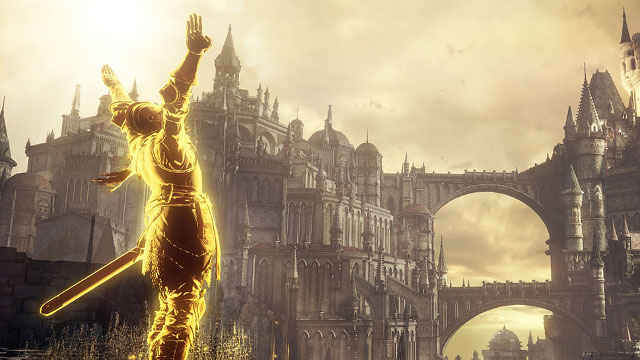
Conclusion: Dark Souls 3 Edges Out Bloodborne
Bloodborne has a wonderfully crafted gothic world and exciting gameplay that have earned it widespread recognition. While retaining the heart of Souls, it manages to successfully diversify FromSoftware's masterpiece-rich portfolio.
However, when compared to Dark Souls 3's superior diversity and polish, Bloodborne is edged out slightly. Dark Souls 3 executes better on what makes an RPG not only compelling, but highly replayable. FromSoftware's final Souls game is equipped to stand the test of time.

Check Out More Dark Souls 3 Coverage At GameRevolution:
